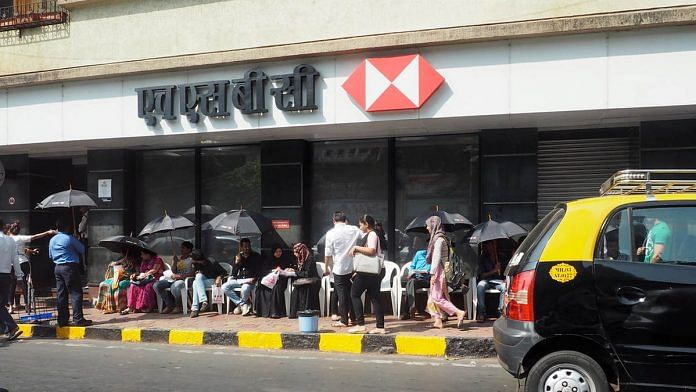New Delhi: The broad finding of a World Bank working paper that extreme poverty in India had decreased by 12.3 percentage points between 2011 and 2019 was widely reported by the media this week.
However, the paper, which was released last week, also included other notable findings, including that urban poverty increased sharply by two percentage points in the aftermath of the Indian government banning Rs 500 and Rs 1000 notes in the demonetisation exercise of 2016 — but also that recovery was quick.
Titled ‘Poverty in India Has Declined over the Last Decade but not as Much as Previously Thought’, and co-authored by economists Sutirtha Sinha Roy and Roy van der Weide, the paper found that extreme poverty decreased from 22.5 per cent in 2011 to 10.2 per cent in 2019. The study also said that the rate at which poverty decreased in the 2011-2019 period is significantly lower than observed over the 2004-2011 period.
In addition to this, the authors noted that poverty reduction rates in rural areas were higher than in urban centres and that there were “two incidences of rising poverty” in the period of analysis. One was that rural poverty rose by 10 basis points in 2019, “likely due to a growth slowdown”, and the other was that “urban poverty rose by 2 percentage points in 2016 during the demonetisation event and fell sharply thereafter.”
Also Read: India’s extreme poverty down by 12.3% in last decade, says World Bank
Demonetisation a blow, but recovery was quick
On 8 November, 2016, Prime Minister Narendra Modi announced the demonetisation of Rs 500 and Rs 1000 denomination notes, avowedly to “break the grip of corruption and black money”.
The move wiped out about 86 per cent of India’s currency overnight, bringing economic activity to a near halt and causing hardships, especially for the poor.
As a result, India’s GDP growth fell from 8.0 per cent in 2015-16 before demonetisation to 6.8 per cent in 2018-19.
However, the rise in urban poverty in 2016 was followed by a “rapid rise in consumption” the following year as the economy was “remonetised”, the study noted.
The study also studied the trajectory of growth in casual wages, using a Consumer Pyramid Household Survey (CPHS) by a private data collection agency (in the absence of a consumer expenditure survey by the government since 2011).
The data suggested that poverty in 2017 was lower than in 2011. The highest poverty reduction rates were observed in 2017 and 2018; the year 2019 saw slightly lower rates of poverty reduction.
“Our estimates of poverty for recent periods are more conservative than earlier projections based on consumption growth in national accounts and other survey data,” it said.
The authors said that casual wages in India grew at an annual rate of 4.1 per cent between 2011 and 2017 as poverty fell by 1.5 percentage points over the period. Casual wage growth was highest in 2017-2018, coinciding with a poverty reduction rate of 2.8 percentage points. However, in 2018-2019, casual wage growth turned negative. The poverty reduction rate slowed down to (-) 0.8 percentage points during this time.
Here, “per cent” refers to the rate of change, whereas a “percentage point” measures the actual amount of change.
Not as rosy as earlier IMF study
The World Bank paper follows another study released this month by the International Monetary Fund (IMF), which said that Centre’s policy of providing free food grains to 80 crore households during the pandemic prevented India from slipping into extreme poverty as it withstood one of the biggest income shocks globally.
The authors of the IMF study had claimed that extreme poverty in India was as low as 0.8 per cent of the population in the pre-pandemic year 2019. The World Bank paper, however, did not echo the claim that India had nearly eliminated extreme poverty.
The World Bank defines the extreme poor as those who survive on less than $1.9 per day on a purchasing power parity (PPP) basis.
More qualitatively, the United Nations defines what it calls “absolute poverty” as “a condition characterised by severe deprivation of basic human needs, including food, safe drinking water, sanitation facilities, health, shelter, education, and information. It depends not only on income, but also on access to services”.
(Edited by Asavari Singh)
Also Read: Modi govt’s anna yojana helped curb rise in extreme poverty during pandemic, says IMF paper



